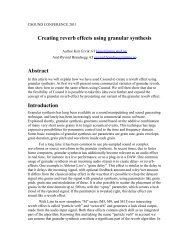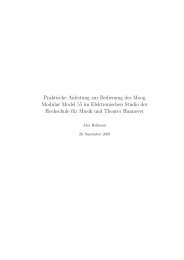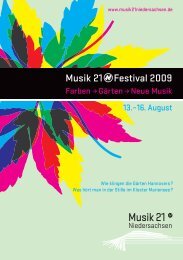Musik im Raum - ZKM
Musik im Raum - ZKM
Musik im Raum - ZKM
Erfolgreiche ePaper selbst erstellen
Machen Sie aus Ihren PDF Publikationen ein blätterbares Flipbook mit unserer einzigartigen Google optimierten e-Paper Software.
4 Works<br />
For the Linux Audio Conference (March 2007), the official opening and the Lange Nacht der<br />
Wissenschaften (June 2007), several compositions have been created for the system, or have been<br />
adapted to the system, by the composers Hans Tutschku, Shintaro Imai, Andre Bartetzki, Victor<br />
Lazzarini, Christian Calon, Michael Amman, Ludger Brümmer and Kirsten Reese. Some of these<br />
compositions are described in more detail in a paper for the ICMC 2007. 8<br />
Acknowledgements<br />
The software will be available from the website http://swonder.sourceforge.net. I would like to<br />
thank Torben Hohn, S<strong>im</strong>on Schampijer, Thilo Koch, Daniel Plewe and Eddie Mond for their cooperation<br />
on the WFS system and technical support for the composers.<br />
1.<br />
2.<br />
3.<br />
4.<br />
5.<br />
6.<br />
7.<br />
C. Moldrzyk, A. Goertz, M. Makarski, W. Ahnert, S. Feistel, and S. Weinzierl, “Wellenfeldsynthese fur einen großen<br />
Hörsaal”, in: DAGA 2007, Stuttgart, 2007; T. Behrens, W. Ahnert, and C. Moldrzyk, “<strong>Raum</strong>akustische Konzeption<br />
von Wiedergaberäumen für Wellenfeldsynthese am Beispiel eines Hörsaals der TU Berlin”, in: DAGA 2007, Stuttgart,<br />
2007.<br />
A. Goertz, M. Makarski, C. Moldrzyk, and S. Weinzierl, “Entwicklung eines achtkanaligen Lautsprechermoduls für die<br />
Wellenfeldsynthese”, in: DAGA 2007, Stuttgart, 2007.<br />
Marije A.J. Baalman, Torben Hohn, S<strong>im</strong>on Schampijer, and Thilo Koch, “Renewed architecture of the sWONDER<br />
software for wave field synthesis on large scale systems”, lecture at Linux Audio Conference 2007, TU Berlin, 22–25<br />
March 2007.<br />
M. Wright, A. Freed, and A. Momeni, “Opensound-control: State of the art 2003”, in: 2003 International Conference<br />
on New Interfaces for Musical Expression, McGill University, Montreal, Canada, 22–24 May 2003, Proceedings,<br />
pp.153–160.<br />
Richard Furse, “Linux Audio Developers S<strong>im</strong>ple Plugin API (LADSPA)”, in: http://www.ladspa.org (18 September<br />
2007)<br />
“Virtual Studio Technology (VST)”, in: http://en.wikipedia.org/wiki/Virtual Studio Technology/ (18 September 2007),<br />
http://ygrabit.steinberg.de (18 September 2007).<br />
Marije A.J. Baalman, “On Wave Field Synthesis and Electro-Acoustic”, lecture at Music – State of the Art 2007, International<br />
Computer Music Conference 2007, 26–31 August 2007, Kopenhagen, Denmark.<br />
Marije Baalman „How to Control 840 Channels“<br />
* * *<br />
Marije Baalman studied Applied Physics at the Technical University in Delft and graduated in 2002<br />
on a topic of Perceptual Acoustics. In 2001/2002 she followed the Sonology Course at the Royal<br />
Conservatory in The Hague.<br />
Currently she is doing her Ph.D. at the Institute for Audio Communication at the Technical University<br />
of Berlin on Wave Field Synthesis and electro-acoustic music. She has presented papers at several<br />
conferences, such as the ICMC, NIME, and the Linux Audio Conference. She has been active<br />
as a sound artist and performer since 2001, and played at venues such as WORM (Rotterdam, NL),<br />
STEIM (Amsterdam, NL), Theater Kikker (Utrecht, NL), Korzo (Den Haag, NL), Club Transmediale<br />
(Berlin, DE), Tesla (Berlin, DE), Electrofringe (Newcastle, AU) and Disorientation (Sydney, AU).<br />
In 2005 she founded together with Alberto de Campo the Institute for Predictive Sonobotanics, as<br />
part of the Foundation for Auralisation and Computation of Transient Objects (IPSO-FACTO).<br />
The results of their work has been presented in several exhibitions, including Experience Art! (Art<br />
Centre Berlin Friedrichstrasse) and Resonances (IRCAM, Paris). Her artistic research interest is the<br />
use of sensor technologies for live performance and installations, and the creation of interactive<br />
systems and dynamic behavior.<br />
56










